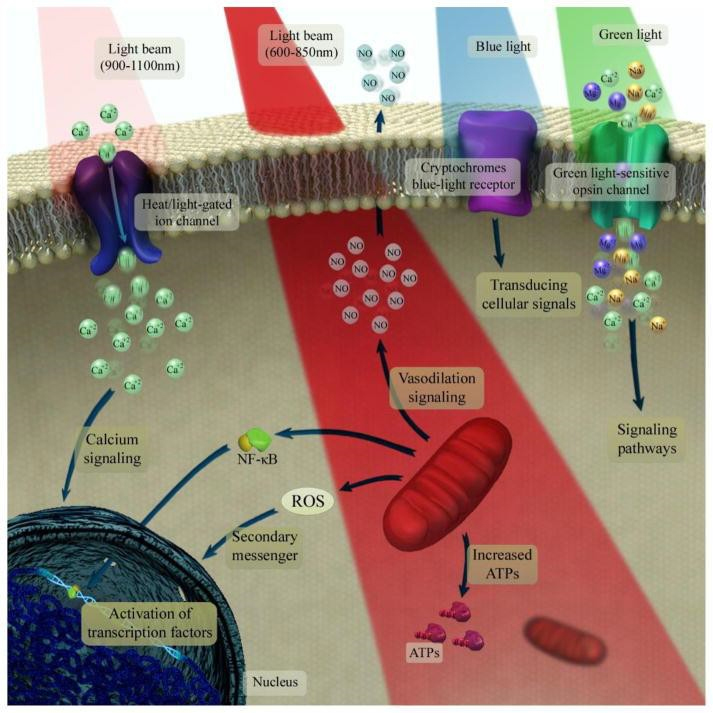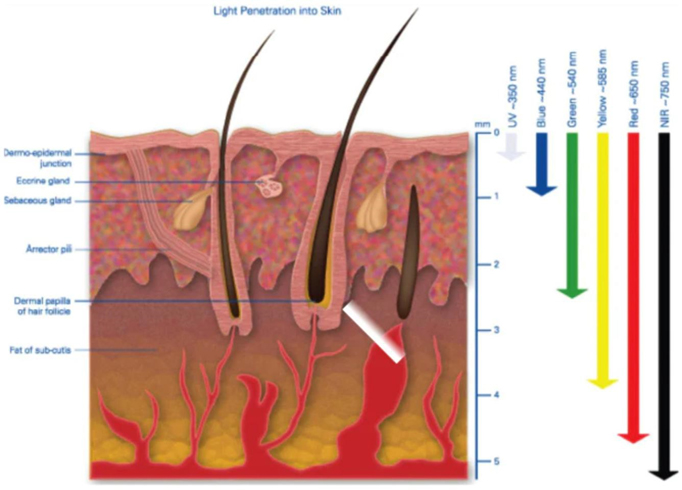Benefits of Different Wavelengths in LED Light Therapy
LED light therapy uses various wavelengths to target different skin concerns and promote overall health.
Here’s a breakdown of the benefits associated with 630 nm, 660 nm, 810 nm, 830 nm, and 850 nm wavelengths, based on scientific research:
630 nm Wavelength
The 630 nm wavelength is ideal for superficial skin treatments. Its benefits include:
- Rejuvenating skin tone and texture
- Smoothing uneven pigmentation
- Reducing fine lines and wrinkles
- Stimulating hair growth
- Managing acne
- Treating mild skin conditions like eczema and psoriasis
- Enhancing wound healing by reducing pain, inflammation, and swelling
While the 630 nm wavelength is beneficial, it’s essential to combine it with other wavelengths (like 660 nm and 850 nm) for optimal results. This approach takes advantage of different spectral absorption
coefficients and targets the “action zones” of 620-660 nm and 800-850 nm.
660 nm Wavelength
The 660 nm wavelength has been extensively studied, and its benefits include:
- Deep tissue penetration to treat muscle fatigue, joint pain, and promote skin rejuvenation
- Enhancing blood flow to aid in rejuvenation, reduce inflammation, and support tissue repair
- Stimulating superior collagen production (when combined with other wavelengths) for improved skin elasticity and reduced fine lines and wrinkles
- Delaying muscle fatigue and enhancing skeletal muscle performance (when combined with NIR light)
The 660 nm wavelength is a key component of red light therapy, offering benefits for both aesthetic and therapeutic applications. Its deep penetration and collagen-stimulating properties make it ideal for skin and tissue health, while its impact on muscle performance makes it beneficial for athletes and
individuals seeking to improve physical well-being.
810 nm Wavelength
LED light therapy at 810 nm offers several benefits:
- Deep tissue penetration (up to 3 cm) to target deeper tissues and organs, like the brain
- Supporting brain health, particularly for traumatic brain injury, depression, and anxiety disorders
- Potentially stimulating mitochondrial function and energy production due to its proximity to the peak absorption spectrum of cytochrome c oxidase
- Being a non-invasive and pain-free treatment option
- Operating at relatively low powers (e.g., 50 mW) while still achieving effective penetration
While both 810 nm and 830 nm wavelengths have been studied, some research suggests 830 nm may have advantages for systemic mechanisms (like skin care, wound healing, eye health, and hair health) and superficial benefits due to its closer match to the absorption spectrum of cytochrome c oxidase.
Further research is needed to fully understand the comparative benefits and drawbacks of 810 nm versus 830 nm.
830 nm Wavelength
The benefits of LED light therapy at 830 nm include:
- Deeper penetration and faster energy delivery than other LED wavelengths
- Higher power density (light intensity) due to the COB LED system used in some devices
- Enhancing wound healing, minimizing secondary infections, and improving blood flow and autonomic nervous system regulation in diabetic foot ulcers
- Indirectly treating burn injuries distant to the irradiated area for faster healing
- Effectively managing pain, particularly for musculoskeletal injuries, and potentially serving as an adjunct to other aesthetic procedures
- Stimulating cellular metabolism, improving circulation, promoting collagen and elastin
production, reducing inflammation, and increasing antioxidant production (when combined with red light) for healthier, younger-looking skin
- Significantly reducing return-to-play time in injured athletes, making it a promising treatment for recovery
850 nm Wavelength
The key benefits associated with 850 nm NIR light include:
- Providing pain relief by reducing inflammation and alleviating muscle and joint pain
- Enhancing skin and deep tissue health, improving collagen production, and promoting wound healing
- Offering synergistic effects when combined with other wavelengths (like 630 nm and 660 nm) for superior collagen production and therapeutic value
- Showing promise in enhancing brain health, including treating brain disorders and aiding in recovery from brain injuries
- Being invisible to the human eye, making it suitable for applications where visibility isn’t a concern
While 850 nm LED lights have several benefits, it’s crucial to consider the specific device and its design, as individual results may vary. Consult with a healthcare professional before using any red light therapy device.
Biophotonic BioHacking
GCF RL uses it propietary biophotonic therapy light to stimulate the body’s regenerative processes. The natural interaction between biological life and light photons is the foundation of all biophotonic therapy. It’s a holistic modality that addresses every dimension of wellness: physical, mental, emotional, and spiritual.
Though the idea seems novel, it’s actually no different than absorbing vitamin D from sunshine. Indeed, biophotonic therapy has been in use since the early 20th century, and its efficacy is proven by empirical research and scientific study, much of which you can find right here, on our “Research” page.
While traditional biophotonics utilize light in the infrared range, known as “red light therapy,” GCF RL does more. Our biohackers employ not only infrared light but also a wider spectrum. Furthermore, our
products are imbued with the frequencies of thirty frequency nutrients. For more information about our GCF RL is truly on the cutting edge.
Anyone interested in biohacking their body using photons to become younger can achieve amazing
results. Definition: A photon is the smallest discrete amount or quantum of electromagnetic radiation. It is the basic unit of light. Imagine a shaft of yellow sunlight beaming through a window. According to
quantum physics, a beam is made of zillions of tiny packets of light, called photons, streaming through the air. Our company uses photons to help repair and rejuvenate the body in a special way.
https://pubmed.ncbi.nlm.nih.gov/29327206
https://www.ncbi.nlm.nih.gov/pmc/articles/PMC6041198/figure/F1
https://www.ncbi.nlm.nih.gov/pmc/articles/PMC6041198/figure/F2

Mechanism of photobiomodulation therapy in mitochondria
(A) The flow of electrons and protons through the mitochondrial respiratory chain. Photobiomodulation stimulates cytochrome c oxidase, improves its catalytic activity, and elevates ATP synthesis. All these results in enhancement of neuronal respiration and metabolic capacity. (B) The structure of cytochrome c oxidase and electrons path through its subunits. The complex contains two copper centers as well as two heme prosthetic groups. Photobiomodulation may dissociate nitric oxide from binuclear center (a3/CuB), allowing oxygen to return, and facilitates electron transfer and increases proton gradient.

Photobiomodulation underlying mechanisms at the cellular and molecular levels
Light at 600–850 nm is absorbed by the mitochondrial electron transfer chain and leads to upregulation of the neuronal respiratory capacity. The near-infrared light at range of 900–1100 nm is absorbed by structured water clusters formed in or on a heat/light-gated ion channels. An increase in vibrational
energy of water cluster leads to perturb the protein structure and opening the channel which ultimately allows modulation of intracellular Ca2+ levels. The absorption of green light by neuronal opsin
photoreceptors (OPN2–5) activates transient receptor potential channels which causes non-selective permeabilization to Ca2+, Na+ and Mg2+. The cryptochromes (a class of flavoprotein blue-light signaling
receptors) absorb blue light and seems to activate the transducing cellular signals via part of the optic nerve to the suprachiasmatic nucleus in the brain, which is important in regulation of the circadian clock.

Learn more about how biophotonic therapy works from Dr. Michael R. Hamblin, one of the leading pioneers in the field of photobiomodulation.
